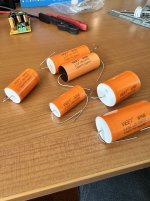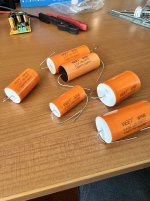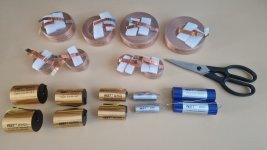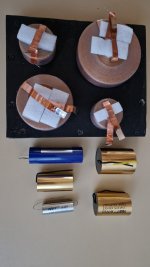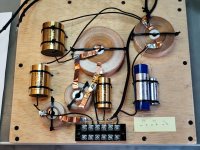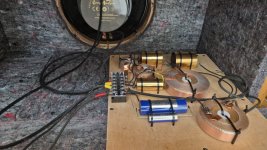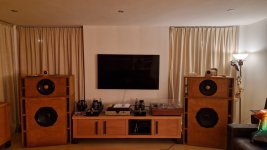Hello fellow audiophiles,
I have been building my own speakers and modifying them for many years. The goal is to achieve the most natural sound quality possible, so that the playback is indistinguishable from an unplugged live performance. A loudspeaker should not have its own sound; after all, it is not a musical instrument but a device meant solely for reproduction. One of the most challenging aspects of designing a good loudspeaker is undoubtedly creating an effective crossover filter. It involves not only calculating the perfect values of the components but also making the right component choices.
Over the past years, I have extensively experimented with capacitors, always trying to use the best possible ones. However, high-quality capacitors are quite expensive, and sometimes it's not feasible to use them due to their high cost. I always use film capacitors based on polypropylene in my designs, as electrolytic capacitors are a no-go for speaker crossovers, at least for me. For low frequencies, you often need capacitors with high values, especially in a three-way system like mine. The midrange driver starts around 60Hz, and I let the woofer roll off around 50Hz to avoid interference frequencies. Using really good film capacitors in this scenario can quickly become quite expensive.
In my design, the midrange driver covers a frequency range from 60Hz to 5KHz. It's a very wide range, but the advantage is that almost all critical frequencies are handled by the same speaker driver, eliminating any crossover interference within this range. For the midrange driver, I need a series capacitor of 100uF, which is quite a high value that can't easily be filled with super expensive capacitors if you don't want to spend a fortune.
Until now, I have used a combination of Jantzen Audio Superior-Z and Jantzen Audio Silver-Z, along with bypassing them with Cornell Dubilier 940C 3000V capacitors. This setup already cost me over €450 per midrange driver. Although I'd like to use even better capacitors, options like Alumen-Z would cost around €1000 per midrange driver, which is not doable for me. Therefore, I was thrilled when I came across the brand WEET on an audio forum on the internet. I checked the capacitors they offer and directly contacted Fay through www.musicaps.com. She was very friendly and professional, addressing all my inquiries excellently. Eventually, I chose 20 pieces of 10uF WEET WMH Aluminium capacitors, and we agreed on a price that was feasible for me.
I then spent two days building my two crossover filters on wooden panels, which I mounted on vibration dampers, externally on the back of the speakers.



After completing the setup, I began listening to the speakers. I know that capacitors, and every conductor in general, even a simple copper wire, as well as all the new sockets, plugs, and not to forget the 0.47mH Litz coil placed in series with the capacitors, need a minimum of 150 hours of playtime before they start sounding as they should. Often, the sound quality reaches only 80% to 90% of its potential during that time, depending on the materials used. For instance, Teflon capacitors require half a century of "breaking in," and silver conductors also need several weeks to reach their full potential. However, I started by playing track no. 2 from the IsoTek Full System Enhancer & Rejuvenation Disc, which is a half-hour long track. I knew there would be quite a noticeable difference after playing this track once only. After 30 minutes, I played a piece of music and started listening.
Right from the first notes from my speakers, I was pleasantly surprised! It already sounded significantly better than what I was accustomed to! Over the following week, I let the speakers play continuously at a low volume. During the night and when I was away from home, I used the IsoTek CD, and when I returned from work, I played music. Every day, I heard improvements, and I must admit that I experienced goosebumps several times while listening. These WEET WMH capacitors achieve an unbelievable high sound quality: the openness, depth, and width of the soundstage, the pinpoint precision, and the realism with which the music is reproduced are of such high quality that at times, I genuinely feel like the musicians are performing in my living room. I have never been a huge fan of live recordings; somehow, I found them less natural and was more drawn to studio recordings. However, that has changed completely now! Every live recording I've heard so far has astonished me; the realism is unlike anything I've ever heard before, even with very exotic speakers and expensive sound systems. I can only use superlatives to describe the experience, and that's precisely how I perceive it. Not just me, but all my audiophile friends who come to my place regularly to listen, while enjoying some drinks and snacks, were amazed as well. The most memorable compliment came from one of these friends who said before leaving: "Thank you, Alex." I asked, "Why?" And he replied with a smiling but serious face, "Now I won't be able to listen to my own setup at home for at least a week because it sounds like an old-fashioned transistor radio compared to this."
I've never received a better compliment, and at the end of this rather lengthy review, I want to pass on the same great compliment to WEET and thank them for all the beauty these capacitors will bring me in the coming years!
The WEET WMH capacitors are not just very good; they are a MUST for anyone who needs higher value in capacitance range and wants to build or modify a relatively affordable crossover filter in such a way that there is no doubt about achieving a realistic reproduction. With the WMH capacitors, you can be certain that at least capacitor quality won't be the limiting factor!
Best regards,
Alex
I have been building my own speakers and modifying them for many years. The goal is to achieve the most natural sound quality possible, so that the playback is indistinguishable from an unplugged live performance. A loudspeaker should not have its own sound; after all, it is not a musical instrument but a device meant solely for reproduction. One of the most challenging aspects of designing a good loudspeaker is undoubtedly creating an effective crossover filter. It involves not only calculating the perfect values of the components but also making the right component choices.
Over the past years, I have extensively experimented with capacitors, always trying to use the best possible ones. However, high-quality capacitors are quite expensive, and sometimes it's not feasible to use them due to their high cost. I always use film capacitors based on polypropylene in my designs, as electrolytic capacitors are a no-go for speaker crossovers, at least for me. For low frequencies, you often need capacitors with high values, especially in a three-way system like mine. The midrange driver starts around 60Hz, and I let the woofer roll off around 50Hz to avoid interference frequencies. Using really good film capacitors in this scenario can quickly become quite expensive.
In my design, the midrange driver covers a frequency range from 60Hz to 5KHz. It's a very wide range, but the advantage is that almost all critical frequencies are handled by the same speaker driver, eliminating any crossover interference within this range. For the midrange driver, I need a series capacitor of 100uF, which is quite a high value that can't easily be filled with super expensive capacitors if you don't want to spend a fortune.
Until now, I have used a combination of Jantzen Audio Superior-Z and Jantzen Audio Silver-Z, along with bypassing them with Cornell Dubilier 940C 3000V capacitors. This setup already cost me over €450 per midrange driver. Although I'd like to use even better capacitors, options like Alumen-Z would cost around €1000 per midrange driver, which is not doable for me. Therefore, I was thrilled when I came across the brand WEET on an audio forum on the internet. I checked the capacitors they offer and directly contacted Fay through www.musicaps.com. She was very friendly and professional, addressing all my inquiries excellently. Eventually, I chose 20 pieces of 10uF WEET WMH Aluminium capacitors, and we agreed on a price that was feasible for me.
I then spent two days building my two crossover filters on wooden panels, which I mounted on vibration dampers, externally on the back of the speakers.
After completing the setup, I began listening to the speakers. I know that capacitors, and every conductor in general, even a simple copper wire, as well as all the new sockets, plugs, and not to forget the 0.47mH Litz coil placed in series with the capacitors, need a minimum of 150 hours of playtime before they start sounding as they should. Often, the sound quality reaches only 80% to 90% of its potential during that time, depending on the materials used. For instance, Teflon capacitors require half a century of "breaking in," and silver conductors also need several weeks to reach their full potential. However, I started by playing track no. 2 from the IsoTek Full System Enhancer & Rejuvenation Disc, which is a half-hour long track. I knew there would be quite a noticeable difference after playing this track once only. After 30 minutes, I played a piece of music and started listening.
Right from the first notes from my speakers, I was pleasantly surprised! It already sounded significantly better than what I was accustomed to! Over the following week, I let the speakers play continuously at a low volume. During the night and when I was away from home, I used the IsoTek CD, and when I returned from work, I played music. Every day, I heard improvements, and I must admit that I experienced goosebumps several times while listening. These WEET WMH capacitors achieve an unbelievable high sound quality: the openness, depth, and width of the soundstage, the pinpoint precision, and the realism with which the music is reproduced are of such high quality that at times, I genuinely feel like the musicians are performing in my living room. I have never been a huge fan of live recordings; somehow, I found them less natural and was more drawn to studio recordings. However, that has changed completely now! Every live recording I've heard so far has astonished me; the realism is unlike anything I've ever heard before, even with very exotic speakers and expensive sound systems. I can only use superlatives to describe the experience, and that's precisely how I perceive it. Not just me, but all my audiophile friends who come to my place regularly to listen, while enjoying some drinks and snacks, were amazed as well. The most memorable compliment came from one of these friends who said before leaving: "Thank you, Alex." I asked, "Why?" And he replied with a smiling but serious face, "Now I won't be able to listen to my own setup at home for at least a week because it sounds like an old-fashioned transistor radio compared to this."
I've never received a better compliment, and at the end of this rather lengthy review, I want to pass on the same great compliment to WEET and thank them for all the beauty these capacitors will bring me in the coming years!
The WEET WMH capacitors are not just very good; they are a MUST for anyone who needs higher value in capacitance range and wants to build or modify a relatively affordable crossover filter in such a way that there is no doubt about achieving a realistic reproduction. With the WMH capacitors, you can be certain that at least capacitor quality won't be the limiting factor!
Best regards,
Alex
Last edited:
Hi again from the Netherlands,
Since last posting there have been a lot of changes in relation to the use of capacitors in my crossovers.
Because of the fact that I really prefer the WEET WMH pure aluminum capacitors over the Jantzen Alumen-Z's I was very interested in testing the WEET WMW pure copper capacitors. In the meantime I ordered a bunch of them and used them in my tweeters crossovers to replace a combination of Jantzen Alumen-z + Jantzen Silver-Z + Jantzen Amber-Z.


As suspected the WEET WMW pure copper capacitors did sound more coherent and musical without losing definition.
Highs still sounding sparkling without the slightest hint of sharpness etc. At the beginning I was afraid that they maybe would sound too warm and could or even would need some bypass capacitors to compensate this. But in the end they sounded perfectly on their own!
Very glad that Fay from WEET offered me to buy a bunch of these WMW capacitors.
But, as said in the beginning of this post, much has changed, so it didn't stop after modifying my crossovers to the WEET WMW capacitors!
I wasn't aware of the fact that WEET also has a super duper high-grade pure copper - polypropylene capcitor in oil!
As you already can imagine I did order some of these so called WEET WMO capacitors to test them




I couldn't wait to use these big boys to replace the WEET WMW capacitors in the crossovers for my tweeters.
Since capacitors need at least 150 hours of playtime before sounding at their best (and sometimes even longer) I waited to write this review about them. To be honest, in fact I waited many months before writing this review. I was rather busy with my daily job and had some other private matters that took longer than expected. After listening month after month to my speakers with these WEET WMO capacitors, I must admit that the only proper thing to say about these WMO capacitors isn't the fact that the sound bright, or dull, or musical, or having a deeper and wider soundstage or not. The only fact that DOES apply to them is that they sound, or perform, AS IF THEY AREN'T THERE AT ALL! I tried this even at low volumes with a set of "old" tweeters, without capacitors and with WMO in series. I couldn't notice any degradation or altering naturalness or coloring sound, it's just as if they aren't there at all.
This probably is the best compliment I can make for a capacitor, doing it's job and leaving no trace of being there at all
 For me this is the endstation in relation to upgrading my crossovers, it seems it sounds too good to be true, but I really don't feel the need of changing anything, anymore. The only thing that comes to my mind is to change the total of 100uF WEET WMH aluminum caps for the mid crossovers to WEET WMO copper capacitors, but that would be an impossible job to accomplish because it would take too much room without constructing a whole enclosure for them. And, last but not least, acquiring 100uF of WEET WMO would be a rather costly modification.
For me this is the endstation in relation to upgrading my crossovers, it seems it sounds too good to be true, but I really don't feel the need of changing anything, anymore. The only thing that comes to my mind is to change the total of 100uF WEET WMH aluminum caps for the mid crossovers to WEET WMO copper capacitors, but that would be an impossible job to accomplish because it would take too much room without constructing a whole enclosure for them. And, last but not least, acquiring 100uF of WEET WMO would be a rather costly modification.
But one still can dream, can't we?
All the best,
Alex
Since last posting there have been a lot of changes in relation to the use of capacitors in my crossovers.
Because of the fact that I really prefer the WEET WMH pure aluminum capacitors over the Jantzen Alumen-Z's I was very interested in testing the WEET WMW pure copper capacitors. In the meantime I ordered a bunch of them and used them in my tweeters crossovers to replace a combination of Jantzen Alumen-z + Jantzen Silver-Z + Jantzen Amber-Z.
As suspected the WEET WMW pure copper capacitors did sound more coherent and musical without losing definition.
Highs still sounding sparkling without the slightest hint of sharpness etc. At the beginning I was afraid that they maybe would sound too warm and could or even would need some bypass capacitors to compensate this. But in the end they sounded perfectly on their own!
Very glad that Fay from WEET offered me to buy a bunch of these WMW capacitors.
But, as said in the beginning of this post, much has changed, so it didn't stop after modifying my crossovers to the WEET WMW capacitors!
I wasn't aware of the fact that WEET also has a super duper high-grade pure copper - polypropylene capcitor in oil!
As you already can imagine I did order some of these so called WEET WMO capacitors to test them
I couldn't wait to use these big boys to replace the WEET WMW capacitors in the crossovers for my tweeters.
Since capacitors need at least 150 hours of playtime before sounding at their best (and sometimes even longer) I waited to write this review about them. To be honest, in fact I waited many months before writing this review. I was rather busy with my daily job and had some other private matters that took longer than expected. After listening month after month to my speakers with these WEET WMO capacitors, I must admit that the only proper thing to say about these WMO capacitors isn't the fact that the sound bright, or dull, or musical, or having a deeper and wider soundstage or not. The only fact that DOES apply to them is that they sound, or perform, AS IF THEY AREN'T THERE AT ALL! I tried this even at low volumes with a set of "old" tweeters, without capacitors and with WMO in series. I couldn't notice any degradation or altering naturalness or coloring sound, it's just as if they aren't there at all.
This probably is the best compliment I can make for a capacitor, doing it's job and leaving no trace of being there at all
But one still can dream, can't we?
All the best,
Alex
Attachments
Following Alex's lead, I also ordered the WEET capacitors and coils.
In my previous 2-way open baffle system, I used Mundorf VN180 + VS180 coils and V-Cap Odam capacitors, which gave a beautiful result.
Later, I switched to a 3-way system: I built the Jensen Onken with an EMS 15” woofer and a top enclosure (similar to Klipschorn or Altec) with a 12” driver and EMS tweeter.
I switched to Jantzen Wax coils and Alumen capacitors, and for the woofer a Mundorf E-Cap. Because of the added tweeter, I had to design a different filter, so I can't give a clear description of that setup.
Afterwards, I made a 3-way second-order filter using Jantzen air coils and C-Coil (woofer) inductors and Cross- and Z-Cap capacitors. Initially, they didn’t sound very good—harsh and sharp. It took nearly 3 months before it started sounding right. Unfortunately, I still wasn't truly satisfied. The EMS drivers are around 98dB, and while the schematic was correct, I knew it could sound better.
I read a lot about crossover design, but every system is different and people’s impressions vary as well. Should I go back to the Jantzen Wax or Mundorf coils? Duelund is unaffordable and generally not available in the values I need.
What’s clear to me is that there’s definitely a difference depending on which type of capacitors and coils you use.
I looked at all brands, read the reviews, and made a choice. Since China already produces many high-quality audio products, WEET caught my eye. I contacted Tess from WEET. The service was excellent—she took all the time and effort to advise me, and I eventually placed the order for the WMO Pure Copper and one WMH Pure Aluminum capacitor, as well as WIC Copper Foil coils.
It takes 2 to 3 weeks for them to be ready for shipping, as everything is made to exact values to meet the specifications of my crossover design.
When I received the coils and capacitors (not a light package, by the way), I was very happy.
Due to time constraints, it took a while before the filters were ready—I still had to make some adjustments to the top enclosure before I could hook everything up.
I use Duelund wiring for the filters, together with Timber Audio speaker cables, and Pink Faun interconnects/power cables, DAC, and streamer.
The Pink Faun 2.12 streamer just got an I2S output with an Ultra OCXO clock to connect to my Pink Faun DAC.
When my monoblocks (Interstage 300B Parallel) and tube preamp were turned on, it was an exciting moment.
I mostly listen to Americana, but also jazz and classical music.
From the very start, there was no harshness or sharpness! It was immediately an improvement over the Jantzen filter.
Especially the bass had increased slightly and was tighter. The mids and highs already sound very musical.
Vocals, in particular, sound very natural, and cello music is very musical.
I still need to listen to more jazz to really hear how, for instance, saxophone comes through.
With folk and blues, it sounds very realistic.
It will still take weeks or even months for the system to be fully broken in, but even now it sounds very beautiful.
I hope it will, of course, get even better.
I plan to upgrade to the Pink Faun 2.16 streamer very soon because of the Ultra OCXO clocks on the motherboard.
I never thought it would make such a big difference—but even for someone with hearing aids, it's clearly noticeable.
Even with vinyl, it clearly took things to the next level.
I’m not going to debate whether it makes sense to use expensive, exotic coils, capacitors, and cables.
That’s for each person to decide for themselves.
If there are audio enthusiasts living nearby, they’re always welcome to stop by and listen to the difference—once the filters are fully broken in.
Over time, I might hook up the previous filter to one speaker again for comparison.
In my opinion, WEET is definitely recommended!
In my previous 2-way open baffle system, I used Mundorf VN180 + VS180 coils and V-Cap Odam capacitors, which gave a beautiful result.
Later, I switched to a 3-way system: I built the Jensen Onken with an EMS 15” woofer and a top enclosure (similar to Klipschorn or Altec) with a 12” driver and EMS tweeter.
I switched to Jantzen Wax coils and Alumen capacitors, and for the woofer a Mundorf E-Cap. Because of the added tweeter, I had to design a different filter, so I can't give a clear description of that setup.
Afterwards, I made a 3-way second-order filter using Jantzen air coils and C-Coil (woofer) inductors and Cross- and Z-Cap capacitors. Initially, they didn’t sound very good—harsh and sharp. It took nearly 3 months before it started sounding right. Unfortunately, I still wasn't truly satisfied. The EMS drivers are around 98dB, and while the schematic was correct, I knew it could sound better.
I read a lot about crossover design, but every system is different and people’s impressions vary as well. Should I go back to the Jantzen Wax or Mundorf coils? Duelund is unaffordable and generally not available in the values I need.
What’s clear to me is that there’s definitely a difference depending on which type of capacitors and coils you use.
I looked at all brands, read the reviews, and made a choice. Since China already produces many high-quality audio products, WEET caught my eye. I contacted Tess from WEET. The service was excellent—she took all the time and effort to advise me, and I eventually placed the order for the WMO Pure Copper and one WMH Pure Aluminum capacitor, as well as WIC Copper Foil coils.
It takes 2 to 3 weeks for them to be ready for shipping, as everything is made to exact values to meet the specifications of my crossover design.
When I received the coils and capacitors (not a light package, by the way), I was very happy.
Due to time constraints, it took a while before the filters were ready—I still had to make some adjustments to the top enclosure before I could hook everything up.
I use Duelund wiring for the filters, together with Timber Audio speaker cables, and Pink Faun interconnects/power cables, DAC, and streamer.
The Pink Faun 2.12 streamer just got an I2S output with an Ultra OCXO clock to connect to my Pink Faun DAC.
When my monoblocks (Interstage 300B Parallel) and tube preamp were turned on, it was an exciting moment.
I mostly listen to Americana, but also jazz and classical music.
From the very start, there was no harshness or sharpness! It was immediately an improvement over the Jantzen filter.
Especially the bass had increased slightly and was tighter. The mids and highs already sound very musical.
Vocals, in particular, sound very natural, and cello music is very musical.
I still need to listen to more jazz to really hear how, for instance, saxophone comes through.
With folk and blues, it sounds very realistic.
It will still take weeks or even months for the system to be fully broken in, but even now it sounds very beautiful.
I hope it will, of course, get even better.
I plan to upgrade to the Pink Faun 2.16 streamer very soon because of the Ultra OCXO clocks on the motherboard.
I never thought it would make such a big difference—but even for someone with hearing aids, it's clearly noticeable.
Even with vinyl, it clearly took things to the next level.
I’m not going to debate whether it makes sense to use expensive, exotic coils, capacitors, and cables.
That’s for each person to decide for themselves.
If there are audio enthusiasts living nearby, they’re always welcome to stop by and listen to the difference—once the filters are fully broken in.
Over time, I might hook up the previous filter to one speaker again for comparison.
In my opinion, WEET is definitely recommended!
- Home
- Loudspeakers
- Multi-Way
- Building a High-End midway crossover with WEE Technology - WEET - WMH capacitors
